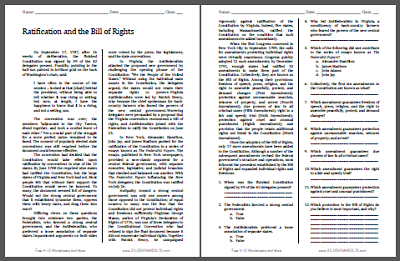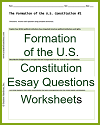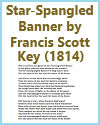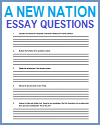| Ratification and the Bill of Rights Reading with Questions |
|---|
| www.studenthandouts.com ↣ American History ↣ American History Readings |
 On September 17, 1787, after 16 weeks of deliberation, the finished Constitution was signed by 39 of the 42 delegates present. Franklin, pointing to the half-sun painted in brilliant gold on the back of Washington's chair, said:
On September 17, 1787, after 16 weeks of deliberation, the finished Constitution was signed by 39 of the 42 delegates present. Franklin, pointing to the half-sun painted in brilliant gold on the back of Washington's chair, said:I have often in the course of the session ... looked at that [chair] behind the president, without being able to tell whether it was rising or setting; but now, at length, I have the happiness to know that it is a rising, and not a setting, sun. The convention was over; the members "adjourned to the City Tavern, dined together, and took a cordial leave of each other." Yet a crucial part of the struggle for a more perfect union remained to be faced. The consent of popularly elected state conventions was still required before the document could become effective. The convention had decided that the Constitution would take effect upon ratification by conventions in nine of the 13 states. By June 1788 the required nine states had ratified the Constitution, but the large states of Virginia and New York had not. Most people felt that without their support the Constitution would never be honored. To many, the document seemed full of dangers: Would not the strong central government that it established tyrannize them, oppress them with heavy taxes, and drag them into wars? Differing views on these questions brought into existence two parties, the Federalists, who favored a strong central government, and the Antifederalists, who preferred a loose association of separate states. Impassioned arguments on both sides were voiced by the press, the legislatures, and the state conventions... Questions with answers in bold: 1. When was the finished Constitution signed by 39 of the 42 delegates present? September 17, 1787 2. The Federalists favored a strong central government. a. True 3. The Antifederalists preferred a loose association of separate states. a. True 4. Who led Antifederalists in Virginia, a constituency of back-country farmers who feared the powers of the new central government? Patrick Henry 5. Which of the following did not contribute to the series of essays known as The Federalist Papers? c. John Adams 6. Collectively, the first ten amendments to the Constitution are known as what? Bill of Rights 7. Which amendment guarantees freedom of speech, press, religion, and the right to assemble peacefully, protest, and demand changes? First Amendment 8. Which amendment guarantees protection against unreasonable searches, seizures of property, and arrest? Fourth Amendment 9. Which amendment guarantees due process of law in all criminal cases? Fifth Amendment 10. Which amendment guarantees the right to a fair and speedy trial? Sixth Amendment 11. Which amendment guarantees protection against cruel and unusual punishment? Eighth Amendment 12. Which protection in the Bill of Rights do you believe is most important, and why? Answers will vary Click here to print. |
 |  |  |  |  |
| www.studenthandouts.com ↣ American History ↣ American History Readings |








